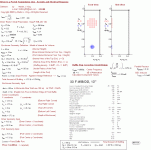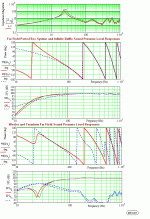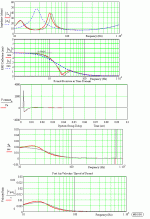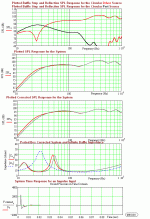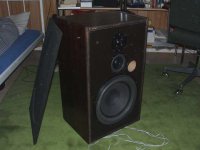Elbert said:
I'm planning to use these woofers for pure "sub-woofing" duty anyway!
Hi, what a waste ........
see : http://www.troelsgravesen.dk/33FWK.htm
Forget about silver cables, golden binding posts, Mundorf Supreme and all that crap! Get an old 12-13" (good) paper cone and let it run up to 5-600 Hz. Give it 50-100 litres of volume or as much as your wife allows. Get a decent 5" paper mid and don't pay more than 50 $ for the tweeter! Get some electrolytic caps and - most importantly - make a good crossover and you're there.
Elbert said:Hei Svante!
Yes, my software actually plots a response curve, and so far I've been aiming for a flat response......
Your point about allowing for a slightly sloping response and to have it "compensated" by the room response is very interesting!
But then again, how does one predict the room response? And what might turn out to be right for my current living room might be completely wrong if (when) I move to another house.... that's the tough one with low frequency audio, the source and the room is really part of the same equation....
The best bet is perhaps to go for a reasonably flat response and use an equalizer for tuning to what ever room they might end up playing in?
Ah, ok. The questions on how to predict the room gain, and also how much of this one should compensate for is not easy to answer.
Even if the room gain of a room is possible to measure and/or calculate it is not necessarily so that it should be fully compensated for. Once we enter a room we get a feel for how much boost there is in the bass, and the brain compensates for this to some extent. This means that some of the bass lift should be left there.
There are several philosophies on how to do this, and what finally determines what is "right" is the monitors that are used in the recording studios. It is a pity that these are not standardised...
Lots of more interresting input here!
Now first of all, I see that I have referenced the wrong data-sheet, my stupid!
This is the right one!http://www.seas.no/images/stories/vintage/pdfdataheet/h172_and_179_33f-wb_and_dd.pdf
I got hold of these drivers in a pair of SEAS kit speakers which I bought at a "loppemarked" for about 10£!
The foam surrounds were completely disintegrated, but i found a replacement set on e-bay, and now they look like new!
The speakers as such are very nice sounding, but with a cabinet volume of around only 60-70 L, I figured that I'd probably get much deeper bass response if I buildt some larger boxes. Of course i could then make the boxer much stiffer with bettrer bracing and better materials.
From there on, the idea of replacing the midrange and the tweeter with something 30 years newer followed quite easily.
So why the low x-over? Well, i figured it would be better having one midrange covering the entire critical midrange area rather than sharing this duty with a 30 year old 13" woofer...
I did some further box modelling, and it seems I can get away with a vented box in the 120-130 L range and stil obttain a F3 of around 35Hz with only a very moderate slope in response which could either be compensated by room effect or active equalizing..
definitive answers were never hoped for in the first place, but just bouncing some ball and getting some reality checks is great and much appreciated!
Now first of all, I see that I have referenced the wrong data-sheet, my stupid!
This is the right one!http://www.seas.no/images/stories/vintage/pdfdataheet/h172_and_179_33f-wb_and_dd.pdf
I got hold of these drivers in a pair of SEAS kit speakers which I bought at a "loppemarked" for about 10£!
The foam surrounds were completely disintegrated, but i found a replacement set on e-bay, and now they look like new!
The speakers as such are very nice sounding, but with a cabinet volume of around only 60-70 L, I figured that I'd probably get much deeper bass response if I buildt some larger boxes. Of course i could then make the boxer much stiffer with bettrer bracing and better materials.
From there on, the idea of replacing the midrange and the tweeter with something 30 years newer followed quite easily.
So why the low x-over? Well, i figured it would be better having one midrange covering the entire critical midrange area rather than sharing this duty with a 30 year old 13" woofer...
I did some further box modelling, and it seems I can get away with a vented box in the 120-130 L range and stil obttain a F3 of around 35Hz with only a very moderate slope in response which could either be compensated by room effect or active equalizing..
definitive answers were never hoped for in the first place, but just bouncing some ball and getting some reality checks is great and much appreciated!
…it seems I can get away with a vented box in the 120-130 L range…
Hi,
Yes you can, I designed a slightly larger box using this driver (Qt= 0.577 or Bessel) a long time ago that I remember performed very well and I believe so will yours likely do too.
b
1(4)
Attachments
Hi Again Bjorno,
Interesting to learn that you have had promising results with the same woofer, something which the plots you have posted seems to substantiate!
What sort of system did you use the woofer in?
I have enclosed an image of one of the loudspeakers I have..
Regrettably it hasn't got the DD version of the unit.
Interesting to learn that you have had promising results with the same woofer, something which the plots you have posted seems to substantiate!
What sort of system did you use the woofer in?
I have enclosed an image of one of the loudspeakers I have..
Regrettably it hasn't got the DD version of the unit.
Attachments
Here's another image of the driver.
Allthough it is 30 years old (!), it still looks like a well buildt unit even by todays standards.
I discussed this driver with a guy at ELTEK, a Norwegian SEAS and DIY dealership, and he was of the opinion that the fundamental motor and driver technology hadn't really changed that much, and that fundamentally it was still a good unit, so that's why i have decided to use these drivers for a new project. After all, a pair of decent 12" woofers are not for free if I were to buy new ones!
Allthough it is 30 years old (!), it still looks like a well buildt unit even by todays standards.
I discussed this driver with a guy at ELTEK, a Norwegian SEAS and DIY dealership, and he was of the opinion that the fundamental motor and driver technology hadn't really changed that much, and that fundamentally it was still a good unit, so that's why i have decided to use these drivers for a new project. After all, a pair of decent 12" woofers are not for free if I were to buy new ones!
Elbert said:Lots of more interresting input here!
........
From there on, the idea of replacing the midrange and the
tweeter with something 30 years newer followed quite easily.
So why the low x-over? Well, i figured it would be better having
one midrange covering the entire critical midrange area rather
than sharing this duty with a 30 year old 13" woofer...
I did some further box modelling, and it seems I can get away with
a vented box in the 120-130 L range and stil obtain a F3 of around
35Hz with only a very moderate slope in response which could
either be compensated by room effect or active equalizing..
Hi,
Err..... no to the low crossover point .... it means more BSC
(baffle step compensation) built into the mid driver and the
matching driver sensitivities go all over the place.
The curves for the bass driver are anechoic and in a box.
The baffle step is clearly shown, mainly from 200Hz to 500Hz.
My box modelling from the data sheet indicates 140L tuned ~ 26Hz.
I cannot find where Troels G discusses highish bass / mid crossover
points, but the general gist is do not run the midrange down into a
region where it needs BSC. A short coil dedicated midrange is by
design suited to this regimen, rather than trying to use a long coil
bass/mid as a midrange - generally for the latter sensitivity is not
high enough.
http://www.rjbaudio.com/Audiofiles/FRDtools.html
http://www.geocities.com/woove99/Spkrbldg/
May help. Seas midrange and treble seem to be the obvious choice,
though the best choice for the mid might be some older units, as
high efficiency pure midranges are very rare nowadays.
what other drivers were in the Seas kit ?
Ah!
This is getting to be fun!
I definitively see your your point for operating the midrange outside the baffle step area so to speak.
I guess my consideration for crossing the midrange over low comes from another angle....
In the 200-2kHz range, the ear identifies the direction of sound by time, i.e. the time difference between a sound reaching each ear.
So my "philosophy" is to use one driver (midrange) dedicated to handle this frequency range. Making two (or more) drivers share this range will inevitably reduce the quality of the stereo imaging.
A bit less scientifically, my second rationale is that the transient response in the lower midrange is probably best reproduced by a smaller unit with a lighter membrane.
As I'm planning for a 3-way active set up, I expect to be able to manage baffle step issues with the help of electronic filter equalization.
And at the end of the day, I'm not striving for a perfectly flat frequency response (room acoustics mess that up anyway), dynamic response and good stereo imaging is more interesting.
Very interesting to learn that you got a F3 of 25 Hz in a 140L box!
That would be great!
Why didn't I get that result from my simulation and what software were you using to model??
The original midrange of the speraker is a SEAS 4,5 unit.http://www.seas.no/images/stories/vintage/pdfdataheet/h143.pdf
I must admit that the response curve for this unit looks incredibly flat and the efficiency is also good. However, considering the fact that it falls short on low frequency capacity (for my intended use) and the fact that a number of interesting new (and presumably better) midrange units have been developed over the last 30 years, they will have to go.
The tweeter is an early SEAS dome long since discontinued, probably this one.http://www.seas.no/images/stories/vintage/pdfdataheet/1_dome_h107.pdf
I have allready decided to try the new Seas DXT tweeters.
Now, for a new midrange, I'm currently a bit lost....
I'm strongly leaning towards SEAS units since I know that they are generally high quality. Also, there is an element of patriotism I must admit, and having an all-SEAS design seems kind of cool..
There seems to be a lot of reference out there in terms of frequency response and distortion, but how can one judge a drivers capability of giving good transient response??
This one looks interesting though...
http://www.seas.no/index.php?option=com_content&task=view&id=102&Itemid=124
Efficiency match is not the prime concern, again an active design gives me some room for adjustments here, but as I'm looking to design a system capable of effortlessly reproducing dynamic music at "realistic" sound pressure levels, a total slouch efficiency wise is not necessarily all to desirable. (using two midranges in stead of one migh be a way out though...)
Whew!
This is getting to be fun!
I definitively see your your point for operating the midrange outside the baffle step area so to speak.
I guess my consideration for crossing the midrange over low comes from another angle....
In the 200-2kHz range, the ear identifies the direction of sound by time, i.e. the time difference between a sound reaching each ear.
So my "philosophy" is to use one driver (midrange) dedicated to handle this frequency range. Making two (or more) drivers share this range will inevitably reduce the quality of the stereo imaging.
A bit less scientifically, my second rationale is that the transient response in the lower midrange is probably best reproduced by a smaller unit with a lighter membrane.
As I'm planning for a 3-way active set up, I expect to be able to manage baffle step issues with the help of electronic filter equalization.
And at the end of the day, I'm not striving for a perfectly flat frequency response (room acoustics mess that up anyway), dynamic response and good stereo imaging is more interesting.
Very interesting to learn that you got a F3 of 25 Hz in a 140L box!
That would be great!
Why didn't I get that result from my simulation and what software were you using to model??
The original midrange of the speraker is a SEAS 4,5 unit.http://www.seas.no/images/stories/vintage/pdfdataheet/h143.pdf
I must admit that the response curve for this unit looks incredibly flat and the efficiency is also good. However, considering the fact that it falls short on low frequency capacity (for my intended use) and the fact that a number of interesting new (and presumably better) midrange units have been developed over the last 30 years, they will have to go.
The tweeter is an early SEAS dome long since discontinued, probably this one.http://www.seas.no/images/stories/vintage/pdfdataheet/1_dome_h107.pdf
I have allready decided to try the new Seas DXT tweeters.
Now, for a new midrange, I'm currently a bit lost....
I'm strongly leaning towards SEAS units since I know that they are generally high quality. Also, there is an element of patriotism I must admit, and having an all-SEAS design seems kind of cool..
There seems to be a lot of reference out there in terms of frequency response and distortion, but how can one judge a drivers capability of giving good transient response??
This one looks interesting though...
http://www.seas.no/index.php?option=com_content&task=view&id=102&Itemid=124
Efficiency match is not the prime concern, again an active design gives me some room for adjustments here, but as I'm looking to design a system capable of effortlessly reproducing dynamic music at "realistic" sound pressure levels, a total slouch efficiency wise is not necessarily all to desirable. (using two midranges in stead of one migh be a way out though...)
Whew!
Very interesting to learn that you got a F3 of 25 Hz in a 140L box!
your links do not work - double http's
Hi,
No. the port tuning frequency I reckon is best is ~ 25Hz.
f3 is 40Hz, f6 is 30Hz and f10 23.5Hz.
FWIW I do not think the midrange unit is shabby, the problems
and solutions have not changed much, though troels g does
suggest the MCA15, which has a very similar reference efficiency.
Tweeters though have definitely moved on. 27TDFC is very good.
We obviously do not see eye to eye as to the point of a large
efficient speaker. With lots of power on tap in a active 3-way
TBH I cannot see the utility over a proper subwoofer driver.
Now if your amplifier was :
http://www.lundahl.se/pdfs/claus_byrith/amplifier_30wpp.pdf
You'd kill for a large efficient 3 way with great bass.
Going nowhere near the bass driver limits ? Who cares ?
That is not the point ....
Oh! My stupid, and I can't even figure out how to edit my post to get rid of that extra http!
Anyway, those interested enough are probably capable of editing the URL as required....
Yes, the midranges are as far as I can judge fairly good units. After all, mine were manufactured back in '78 and I believe its perhaps only a couple of years since they were discontinued by SEAS. A design running for almost 30 years must have had something going for it!
As you say, there has probably been few quantum leaps in midrange technology over the past years, perhaps except for the more (seemingly) successful metal cone designs.
I decided to go for the DXT tweeter as I find the directivity control feature very interesting.http://www.seas.no/index.php?option=com_content&task=view&id=184&Itemid=179
Perhaps not so much not seeing eye to eye as having different priorities towards one wants from a speaker system....
At the moment I have Two Coral flat8 fullranges in voihgt horns assisted by Coral H-24 horn tweeters above 8kHz, and an active sub crossed over at 80Hz. Absolutely not linear and probably full of other flaws, but very engaging and dynamic reproducers of music!
You might say I'm looking to achieve something with the same level (or perhaps even better) dynamic transient response together with improved stereo imaging and power handling offered by 30 year newer technology.

Anyway, those interested enough are probably capable of editing the URL as required....
Yes, the midranges are as far as I can judge fairly good units. After all, mine were manufactured back in '78 and I believe its perhaps only a couple of years since they were discontinued by SEAS. A design running for almost 30 years must have had something going for it!
As you say, there has probably been few quantum leaps in midrange technology over the past years, perhaps except for the more (seemingly) successful metal cone designs.
I decided to go for the DXT tweeter as I find the directivity control feature very interesting.http://www.seas.no/index.php?option=com_content&task=view&id=184&Itemid=179
Perhaps not so much not seeing eye to eye as having different priorities towards one wants from a speaker system....
At the moment I have Two Coral flat8 fullranges in voihgt horns assisted by Coral H-24 horn tweeters above 8kHz, and an active sub crossed over at 80Hz. Absolutely not linear and probably full of other flaws, but very engaging and dynamic reproducers of music!
You might say I'm looking to achieve something with the same level (or perhaps even better) dynamic transient response together with improved stereo imaging and power handling offered by 30 year newer technology.
- Status
- This old topic is closed. If you want to reopen this topic, contact a moderator using the "Report Post" button.
- Home
- Loudspeakers
- Multi-Way
- Very large enclosure issue...
